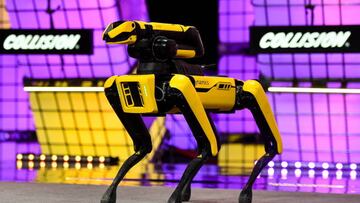How is NASA planning to explore caves on Mars?
With ground breaking technology now being applied, NASA and Boston Dynamics may have just found the next piece to the puzzle of exploring other worlds like Mars.

In the wake of caves being discovered on Mars, scientists say that they are a crucial place to look for signs of life, but how can we explore the dark and foreign depths of another world?
NASA believes caves are the answer while BRAILLE has the question
When it comes to looking for life whether past or present, Caves have often been regarded as one of the best places to look. Nature’s equivalent of a human house, caves can offer protection from from cosmic rays and extreme temperature fluctuations around our solar system and of course the elements in general. That’s precisely why a NASA project called BRAILLE is now working on exploring Mars-like caves that already exist on Earth in order to perfect the techniques and technologies required for future missions.
According to researchers, BRAILLE which involves the use of fully autonomous robots for the purpose of exploration of these types of caves, is an absolute first. The caves which are several hundred meters long and as such make communication with the surface problematic, are the perfect test for the robots. They explore environments without any prior knowledge while a a team of researchers outside the cave perform actions that scientists on Earth would logically be responsible for during an actual mission on Mars. Project lead Ali Agha spoke of the research saying that he believes it could “fundamentally change how we think about future missions. ...Future potential human exploration missions can benefit from robots in many different ways. Particularly, robots can be sent in precursor missions to provide more information about the destination before humans land on those destinations. In addition, robots can accompany astronauts during the missions to help with scouting certain terrains or with logistics and many tasks that can make astronauts’ missions safer and more efficient.”
NeBula will be the driving force behind robot exploration
The challenges of exploring another world will of course differ greatly from doing so on Earth, but how? For starters robots used on Mars will understandably have no direct contact with scientists on Earth, which means their ability to make decisions after processing information will be something quite apart from the kind of robots used on Earth. That brings us to the AI robot brain which is called NeBula. According to Agha, it will be distinctly different.
Yet that’s only the beginning. Where the robot’s body is concerned, one can imagine that things are going to be even more complicated. Scientists will need to consider among other things temperature management and radiation protection and that’s before we factor in the energy and powered required to make a journey to another planet.
Could Boston Dynamics’ SPOT be the solution for NeBula
As mentioned above the requirements of the robotic housing for NeBula will be varied and complex to say the least, but it just may be that engineering and robotics design company Boston Dynamics has the answer. Enter SPOT, a fully autonomous robotic ‘dog’ that is the product of years of research and testing by engineering by Boston Dynamics. “SPOT is one of the most capable robots that we have and it is amazing to see how it successfully reacts to high-level decisions and commands coming from the robot brain and how it can maintain stability over rough and extreme terrains,” Agha said. “In addition to our capable traditional wheeled rovers, the ability to “walk” is a huge asset when dealing with uneven terrains with no roads and no flat surfaces.”
In keeping with Agha’s comments, it’s important to understand that there are three key factors in play where the robot’s success is concerned. Firstly, it must be able to carry enough payload for its eyes, ears and brain to be able to traverse the challenging Martian or lunar terrain. Secondly, it will be required to carry the requisite amount of scientific equipment. Last but not least, it will naturally be asked to maintain a “reasonable” amount of stability, speed and endurance while it navigates another world. “We have these multiple mobile robots that can carry different instruments, as opposed to one big robot that’s going to have trouble traversing its terrain,” said deputy project lead Benjamin Morrell, referring to past Martian rovers. “Boston Dynamics Spot robot is one of the few robots that satisfy these constraints simultaneously,” Agha said. “So integrating our robot brain, NeBula, on Spot has been pushing the boundaries of what was possible in exploring unknown Mars-like environments.”
How would NASA’s cave exploration work with SPOT?
It’s certain - as mentioned before - that the robots won’t be able to communicate with scientists once they are inside the caves. What that means is that scientists will have to wait for robots to return with what they hope will be data such as 3D maps of the cave’s interior, information on specific targets as well as general purpose information about the environment itself. It is understood that some robots have even been outfitted with arms which could presumably be sued to bring back physical samples. Researchers are in fact hoping to move towards a point where robots will be able to perform missions with complete autonomy.
“The next-generation robot bodies and mechanical locomotion capabilities would enable new types of missions over terrains that were otherwise inaccessible by traditional rovers,” Agha said. “Also, due to the increased speed and traversal capabilities, future missions can target destinations that are traditionally considered to be too far from landable regions on Mars.”






